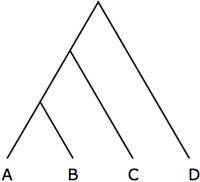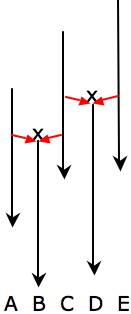Human Evolution Tree?
Or Human Evolution Web?
|
|
| < | Timeline |
Works Cited | > |

|
Is there a human evolution tree? If so, then no one has been able to determine its configuration, nor what its branches might be. When it comes to relationships among hominids, there is no consensus. There seems to be a different tree for each different researcher in the field.
Of course, it's generally assumed that some true tree does exist, which could be determined if only enough data were available. This hypothetical, treelike evolutionary configuration is shown at right.

|
But perhaps the notion of a human evolution tree is only wishful thinking. It's entirely possible that the topology of human origins is fundamentally different from the one traditionally proposed. Perhaps the truth about human ancestry is that it takes the shape of a web?
If the view of evolution presented on this website, stabilization theory, is correct, then new types of organisms arise, typically, as the products of hybridization between two or more preexisting types. Under this view, there would be no tree of human evolution. Instead, there would be an interconnected network of hybridizing types extending back through time. This topology of evolution would look more like the figure at left, where hominids C and E, cross to produce hominid D and, later, hominids A and C, hybridize to create hominid B. Under these circumstances there is no tree.
Paleontological research has clearly shown that multiple hominids existed concurrently over much of the history of human evolution (see the human evolution timeline). So there would, at most times, be multiple types of hominids to hybridize to produce new types.
Perhaps it's really a waste of time trying to reconstruct the "true" tree of human evolution, as so many scientists have tried to do, because the true pattern of descent is not even like a tree. Indeed, the fact that so many mutually contradictory trees have been proposed over the years is entirely consistent with the conclusion that no "real" tree exists.
More about Stabilization Theory >>
Most shared on Macroevolution.net:
Human Origins: Are we hybrids?
On the Origins of New Forms of Life
Mammalian Hybrids
Cat-rabbit Hybrids: Fact or fiction?
Famous Biologists
Dog-cow Hybrids
Georges Cuvier: A Biography
Prothero: A Rebuttal
Branches of Biology
Dog-fox Hybrids